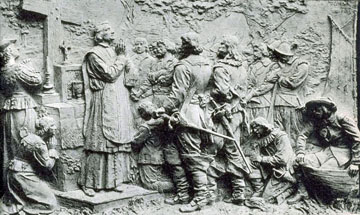The story of the founding of Montreal is perhaps unique in history, wrote historian Gustave Lanctot: "the birth of a town dedicated to the Virgin whose only goal was the glory of God and the conversion of the natives."
Seventeenth-century Europeans were obsessed with converting the world's "savages" to their own beliefs. In France the publication of the Jesuit Relations sparked an apostolic zeal and the dream of founding a Christian mission on the Island of Montreal had come in a mystic vision to a humble tax collector named Jérôme le Royer de la Dauversière.
With persistent zeal Le Royer managed to raise the money for an expedition. He knew that the undertaking needed a leader of strong religious and military abilities. When Paul de Chomedey de Maisonneuve came to his attention as a "man of prayer, brave and just," he immediately engaged him.
Shortly before the expeditions' departure, another volunteer came forward. Jeanne Mance also had an irresistible urge to serve God in New France. She was an intelligent, impulsive woman of 34, with beautiful eyes. News of her decision to go to New France excited interest in courts across Europe. She inspired a rich widow, Marquise de Bullion, to donate enough money to found a hospital, an Hôtel-Dieu, in the new colony.
Maisonneuve and Mance left La Rochelle in May 1641 with 47 men, two women and a few children. They spent the winter at Quebec, readying for the voyage upriver and listening to the admonitions of the authorities. The Jesuits in particular opposed the enterprise, calling it foolhardy and dangerous. Maisonneuve replied, famously, that for him it was "a question of honour, and you will find it good that I go up there to begin a colony even though every tree of this island were to change into an Iroquois."
On May 8, 1642, with the St Lawrence River at last free of ice, the expedition set out for its destination. Accustomed to the gentle rivers of France the colonists were astonished at the grandeur of the St Lawrence. By May 17 the little pinnace was hugging the coast of the island and the next morning the expedition landed to hold its little celebration.
It was obvious to anyone that the Island of Montreal was wonderfully suited to settlement. Thanks to the converging rivers, the island is a great crossroad in the geography of North America. Before the French, the island had been occupied by a group of Iroquois, who had mysteriously disappeared from their grand village of Hochelaga between the visits of Jacques Cartier in 1535 and 1541.

|
| Maisonneuve monument, Montreal. |
That first day the settlers put up tents and unloaded supplies. On August 28 the missionaries proudly recorded their first baptism, of a four-year old Algonquin, whom they named Joseph. By the time winter arrived the colonists had built a wall of solid stakes, a large temporary residence for Governor Maisonneuve and Jeanne Mance and four small houses for the rest.
The Iroquois first caught wind of the existence of Ville-Marie by word of mouth. The settlement was a threat to their trade routes. They came to reconnoiter on June 9, 1643, killing 3 men and taking 3 as prisoners. Soon the colony was under constant siege from Iroquois war parties. In one encounter the governor found himself facing a party of warriors alone. He managed to kill the chief and escaped as the others carried their dead leader to safety.
In 1653 Maisonneuve returned from France with 105 soldiers, effectively tripling the defence of the village. After a few years of peace, Ville-Marie's roots grew deeper.
After years of neglect, in 1663 Louis XIV finally decided to help. He put the colony under royal protection and sent reinforcements. But just as the survival of the colony was assured, a grievous piece of news depressed the spirits of the inhabitants of Ville-Marie. Both the governor and bishop in Quebec were suspicious of the whole enterprise and they found an excuse to have its leader recalled. Maisonneuve went to live in Paris, where he died alone. If his city has gone on to serve Mammon as much as God, the founder still left his mark forever on one of America's great cities.

 Share on Facebook
Share on Facebook Share on X
Share on X Share by Email
Share by Email Share on Google Classroom
Share on Google Classroom